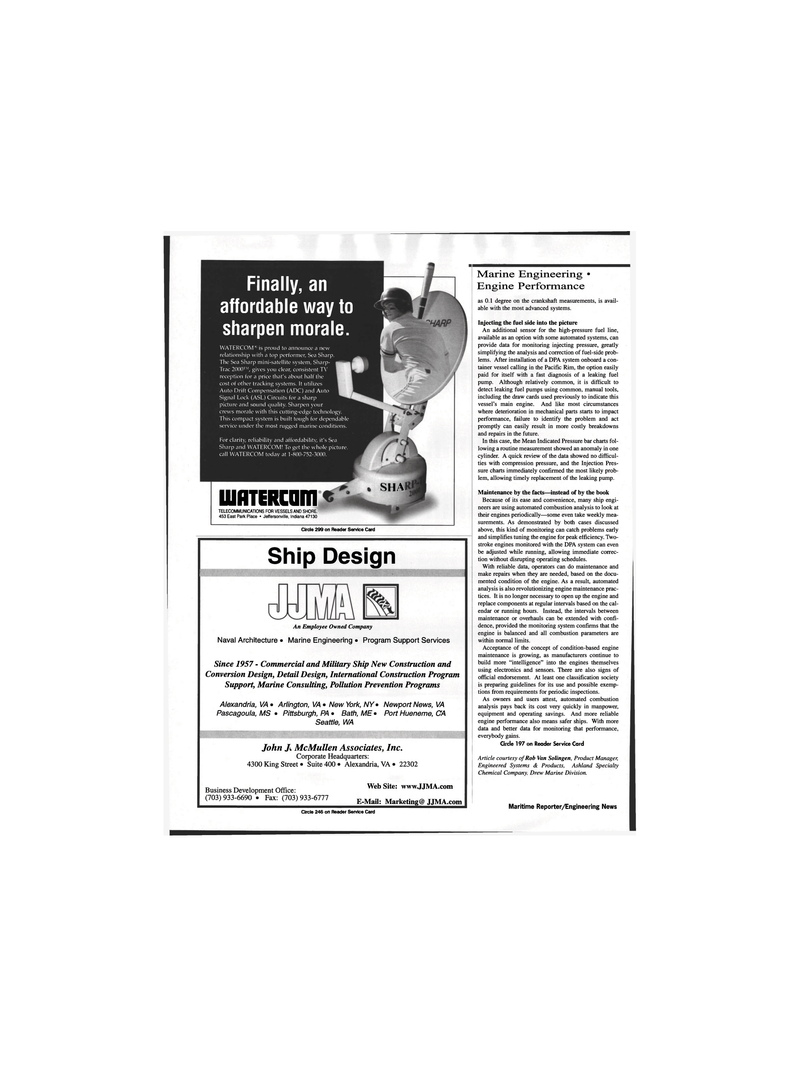
Page 30: of Maritime Reporter Magazine (August 1999)
Read this page in Pdf, Flash or Html5 edition of August 1999 Maritime Reporter Magazine
Finally, an affordable way to sharpen morale.
WATERCOM" is proud to announce a new relationship with a top performer, Sea Sharp.
The Sea Sharp mini-satellite system, Sharp-
Trac 2000™, gives you clear, consistent TV reception for a price that's about half the cost of other tracking systems. It utilizes
Auto Drift Compensation (ADC) and Auto
Signal Lock (ASL) Circuits for a sharp picture and sound quality. Sharpen your crews morale with this cutting-edge technology.
This compact system is built tough for dependable service under the most rugged marine conditions.
For clarity, reliability and affordability, it's Sea
Sharp and WATERCOM! To get the whole picture call WATERCOM today at 1-800-752-3000. lUHTERCam
TELECOMMUNICATIONS FOR VESSELS AND SHORE. 453 East Park Place • Jeffersonville, Indiana 47130
SUA
Circle 299 on Reader Service Card
Ship Design
An Employee Owned Company
Naval Architecture • Marine Engineering • Program Support Services
Since 1957 - Commercial and Military Ship New Construction and
Conversion Design, Detail Design, International Construction Program
Support, Marine Consulting, Pollution Prevention Programs
Alexandria, VA • Arlington, VA • New York, NY• Newport News, VA
Pascagoula, MS • Pittsburgh, PA • Bath, ME • Port Hueneme, CA
Seattle, WA
John J. McMullen Associates, Inc.
Corporate Headquarters: 4300 King Street • Suite 400 • Alexandria, VA • 22302
Business Development Office: (703)933-6690 • Fax: (703) 933-6777
Web Site: www.JJMA.com
E-Mail: Marketing@ JJMA.com
Circle 246 on Reader Service Card
Marine Engineering •
Engine Performance as 0.1 degree on the crankshaft measurements, is avail- able with the most advanced systems.
Injecting the fuel side into the picture
An additional sensor for the high-pressure fuel line, available as an option with some automated systems, can provide data for monitoring injecting pressure, greatly simplifying the analysis and correction of fuel-side prob- lems. After installation of a DPA system onboard a con- tainer vessel calling in the Pacific Rim, the option easily paid for itself with a fast diagnosis of a leaking fuel pump. Although relatively common, it is difficult to detect leaking fuel pumps using common, manual tools, including the draw cards used previously to indicate this vessel's main engine. And like most circumstances where deterioration in mechanical parts starts to impact performance, failure to identify the problem and act promptly can easily result in more costly breakdowns and repairs in the future.
In this case, the Mean Indicated Pressure bar charts fol- lowing a routine measurement showed an anomaly in one cylinder. A quick review of the data showed no difficul- ties with compression pressure, and the Injection Pres- sure charts immediately confirmed the most likely prob- lem, allowing timely replacement of the leaking pump.
Maintenance by the facts—instead of by the book
Because of its ease and convenience, many ship engi- neers are using automated combustion analysis to look at their engines periodically—some even take weekly mea- surements. As demonstrated by both cases discussed above, this kind of monitoring can catch problems early and simplifies tuning the engine for peak efficiency. Two- stroke engines monitored with the DPA system can even be adjusted while running, allowing immediate correc- tion without disrupting operating schedules.
With reliable data, operators can do maintenance and make repairs when they are needed, based on the docu- mented condition of the engine. As a result, automated analysis is also revolutionizing engine maintenance prac- tices. It is no longer necessary to open up the engine and replace components at regular intervals based on the cal- endar or running hours. Instead, the intervals between maintenance or overhauls can be extended with confi- dence, provided the monitoring system confirms that the engine is balanced and all combustion parameters are within normal limits.
Acceptance of the concept of condition-based engine maintenance is growing, as manufacturers continue to build more "intelligence" into the engines themselves using electronics and sensors. There are also signs of official endorsement. At least one classification society is preparing guidelines for its use and possible exemp- tions from requirements for periodic inspections.
As owners and users attest, automated combustion analysis pays back its cost very quickly in manpower, equipment and operating savings. And more reliable engine performance also means safer ships. With more data and better data for monitoring that performance, everybody gains.
Circle 197 on Reader Service Card
Article courtesy of Rob Van Solingen, Product Manager,
Engineered Systems & Products, Ashland Specialty
Chemical Company, Drew Marine Division.
Maritime Reporter/Engineering News

 29
29

 31
31
